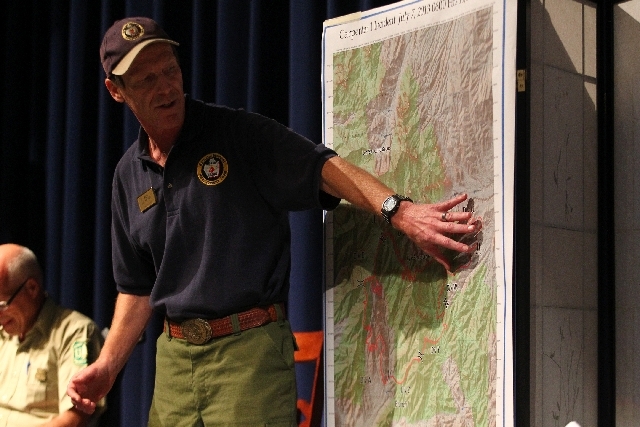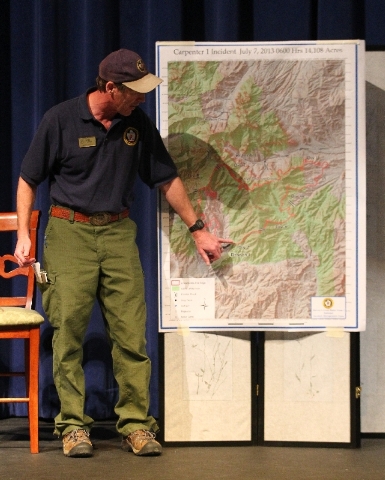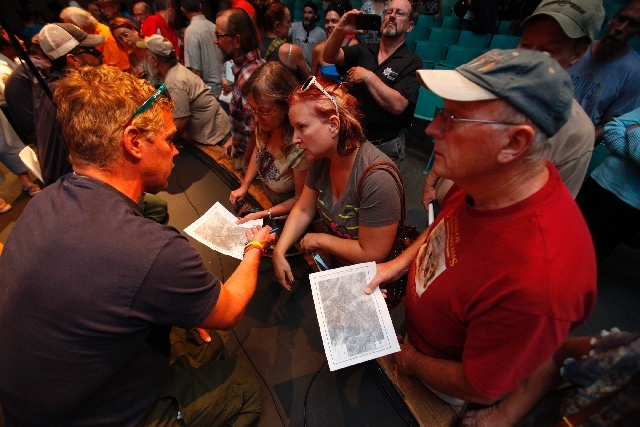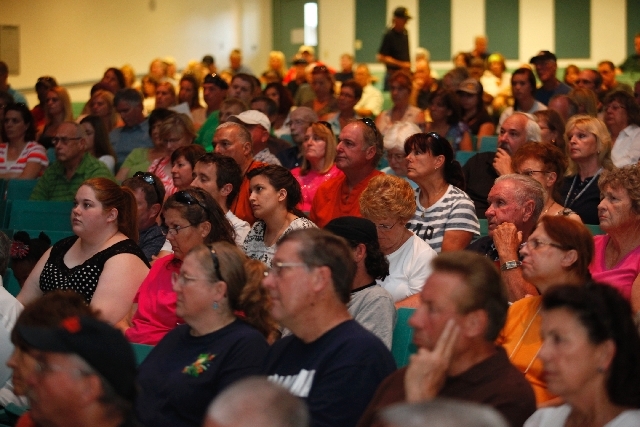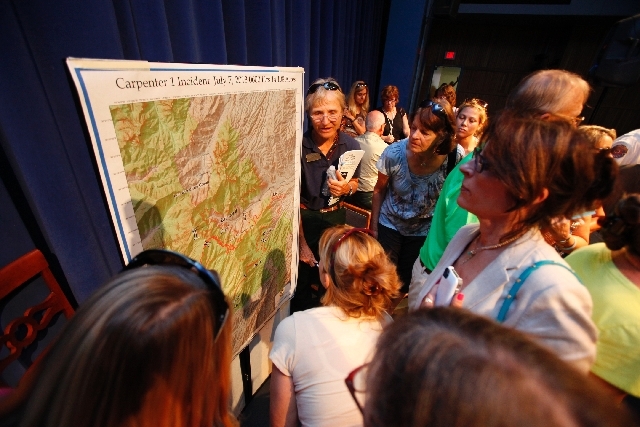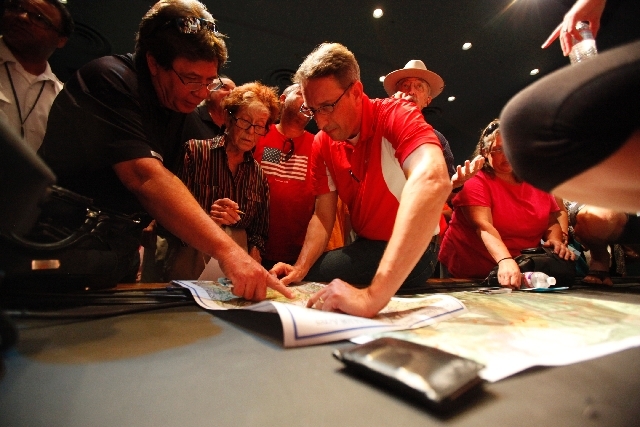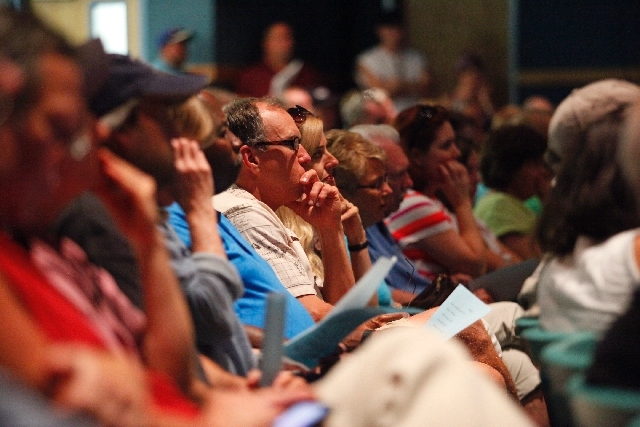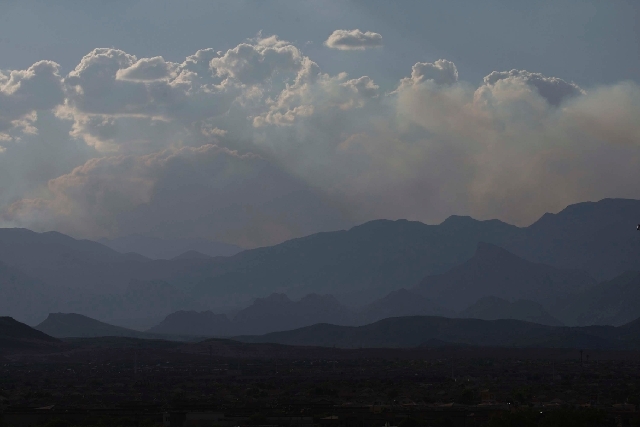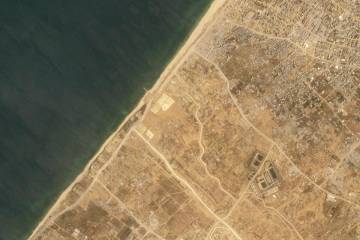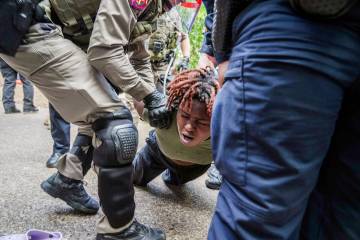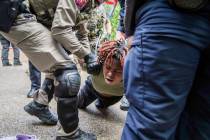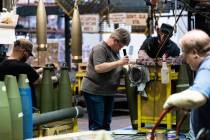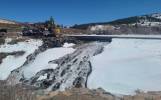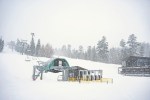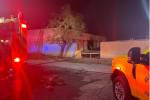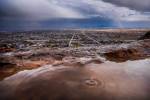Mount Charleston fire ’15 percent contained,’ officials say
A heavy atmosphere filled the theater of Centennial High School on Sunday evening as fire officials informed residents of the Spring Mountains and community members about the Carpenter Canyon fire.
More than 100 people attended the meeting looking for answers, good news or bad. Grateful applause broke out when Type 1 Great Basin Incident Commander Rich Harvey announced that about 15 percent of the 14,500-acre blaze was contained as of Sunday evening.
But given a chance to speak, some residents expressed their concerns.
“Why was no ground resources assigned to the defensible space on the south loop (of the ridge) when this started?” one resident repeatedly asked.
Another resident asked why aircraft weren’t utilized during the initial attack when firefighters realized they could not reach the flames by the ground. The frustration even caused one woman to storm out.
Although emotions were still high, most residents shook hands and thanked fire officials for their services.
“They’re trying their best to help us and keep our homes safe in the process,” community member Shelley Rhemming said. “We shouldn’t bite the hand that feeds us.”
On Sunday, crews began to slowly make progress against the fire as it inched toward homes and businesses in Kyle Canyon.
Though the wildfire grew about 500 acres to 14,458 since Saturday night, crews were able to increase their containment to 15 percent by Sunday evening.
“It’s been one step forward, half step back,” said Harvey, whose team took over command of fire operations Sunday morning.
The fire is burning down the hill near the Rainbow subdivision, with flames as close as a quarter-mile to some structures. However, with five Clark County fire engines and at least one hot shot crew working the area, Harvey insisted that no structures in the area were in any imminent danger.
Harvey described the fire in the Rainbow area as a “backing” fire, which he compared to a lit match held upright, which burns much slower than a lit match flipped upside down.
“Slow is good,” he said.
Crews have managed to take control on the southern end of the fire, near the Trout Canyon entrance, Harvey said. Firefighters will continue to work outward from that contained area, but because of the incredibly difficult terrain, the process could be slow.
“We know this is not a one-day event,” Harvey said. “We’re ready for the grind.”
The area near the peak of Mount Charleston is too dangerous for ground units, even the elite hot shot crews, because of what Harvey called “goat rock country.” The terrain is steep, rocky and provides little to no escape if things were to take a turn for the worse.
The one advantage to “goat rock country” is that it doesn’t burn, which has slowed down the fire’s progress and has provided somewhat of a natural fire barrier for the crews.
According to incident commander spokesman Brandon Hampton, crews plan to utilize the rocky terrain to help route the fire to a manageable position while air units continue to dump thousands of gallons of water to help prevent a possible spreading of the fire from falling embers.
Additional crews have been flying in from all over the West to help contain the immense wildfire.
“When I arrived earlier in the week, there was a huge strain (on resources),” said Marty Adell, Type II incident commander who is overseeing the Pahrump side of the operation. “But within the past three or four days, we’ve been picking up a lot more resources because the other regional fires are becoming more contained.”
More than 100 additional personnel arrived Sunday to help fight the fire, bringing the total number to 753. More units, including an additional hot shot crew, have been ordered and will be arriving in the coming days.
The fire is now occupying nine of the 100 hot shot units in the United States, Harvey said.
“This is the No. 1 priority fire in the nation,” Harvey said. “It is getting the resources that we’re ordering.”
Those additional resources include more hot shot crew support, additional helicopters, numerous Type II units, and possibly four air tankers, officials said.
“The entire West has fires, and there are finite numbers of stuff available to us to get,” Harvey said. “I feel we are doing a pretty good job of getting resources in here.”
In addition to national fire crews, the Clark County Fire Department has stationed five engines and dozens of firefighters in the Rainbow subdivision of Kyle Canyon. Those crews are working to provide additional support to the hot shot crews as well as prevent any structure damage, Clark County Fire Chief Fernandez Leary said.
“One of the most impressive statistics with this fire is that we haven’t lost any structures,” Hampton said.
The cost to date of the fire is now more than $2.4 million.
“We expect that to grow as we do a better job of capturing the aviation assets that we’ve had flying over,” Harvey said.
The mountain’s low humidity rate, unpredictable winds and high temperatures have made containment difficult for firefighters.
Bureau of Land Management fire specialist Nick Yturri said the dry air mass scheduled for today and Tuesday could potentially create a bigger problem for firefighters by bringing stronger winds and higher temperatures.
“Persistent drought conditions mixed with dry fuels and the weather getting hotter and drier makes things much more challenging for firefighters,” Yturri said. “All our fuel types are very susceptible to ignition. We have probability of any one of those embers igniting a flame anywhere from 80 to 100 percent.”
Unfortunately, the thunderstorm that rolled through Sunday afternoon brought little relief for fire crews by bringing lightning and strong winds.
“We picked up two additional fires sparked by lightning, but both were caught fairly small,” Yturri said. “The winds have not subsided in Kyle Canyon. We have up-slope and down-slope winds in various places along the ridge.”
In addition, the fire did not receive any of the valley’s rainfall.
“The humidity cover we’re getting now isn’t good enough to stop it,” Yturri said.
The National Weather Service forecast winds between 10 and 20 mph for today and Tuesday with temperatures around the mid-80s for elevations above 8,000 feet.
Lower humidity rates are expected to continue this week with the next chance of rain expected Friday, according to the weather service.
“It is going to be drier, but everything is already dry up there to begin with,” a weather service spokesman said. “If it’s going to burn, it’s going to burn.”
Contact reporter Caitlyn Belcher at cbelcher
@reviewjournal.com or 702-383-0264. Contact reporter Colton Lochhead at clochhead@reviewjournal.com or 702-383-4638. Follow him on twitter @clochhead44.
FIRE INFORMATION
Spring Mountains Recreation Area
inciweb.org
702-515-5105



